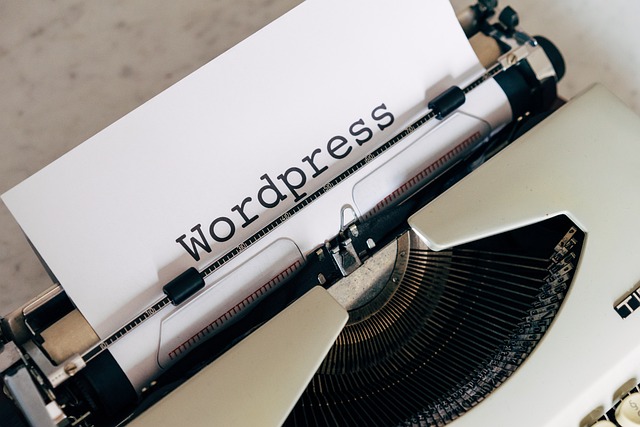Internal linking is a powerful SEO strategy for WordPress sites, improving user engagement and search engine rankings. Using a linking plugin like Yoast SEO or Rank Math, which is easily installed and configured, allows you to create strategic internal link structures. Key steps include identifying core pages, generating links based on content similarity and popular queries, optimizing for high-quality relevant content, and naturally placing links within context. Regularly monitor link performance using tools like Google Search Console and Analytics to make data-driven adjustments. By focusing on descriptive anchor text, interconnecting relevant pages, and maintaining a natural flow, you can significantly enhance site visibility and user experience through effective use of a WordPress linking plugin.
Mastering internal linking is key to enhancing your WordPress site’s SEO. This comprehensive tutorial guides you through every step, from understanding the essence of internal links in search engine optimization to choosing and installing the best WordPress linking plugins. We’ll show you how to create a strategic structure, optimize anchor text, monitor performance, and more. By following these detailed walkthroughs, learn the art of leveraging your site’s content with effective internal linking using WordPress plugins.
- Understanding Internal Linking: Why It Matters for SEO in WordPress
- Choosing the Right WordPress Linking Plugin: Features to Look For
- Installing and Setting Up Your Selected Plugin
- Creating a Strategic Internal Linking Structure
- Optimizing Anchor Text and Context for Search Engines
- Monitoring and Analyzing Your Internal Link Performance
Understanding Internal Linking: Why It Matters for SEO in WordPress

Internal linking is a fundamental SEO strategy that can significantly impact your WordPress website’s visibility and user engagement. It involves creating relevant connections between pages on your site, allowing users to navigate effortlessly while search engines crawl and index your content. By implementing a well-crafted internal linking structure, you tell both users and search algorithms which content is valuable and related, fostering a better browsing experience.
Using a WordPress linking plugin can streamline this process, offering various tips and strategies for optimization. These plugins provide an interface to easily identify pages that need internal links and suggest relevant anchor text, ensuring your site’s architecture is search-engine friendly. With the right WordPress linking plugin, you can enhance your website’s SEO by improving user flow, reducing bounce rates, and helping search engines understand your content hierarchy—all crucial aspects for ranking higher in search results.
Choosing the Right WordPress Linking Plugin: Features to Look For

When it comes to mastering internal linking on WordPress, selecting the right linking plugin is a strategic move that can significantly enhance your SEO efforts. The ideal plugin offers features tailored for creating effective link structures within your site’s content. Look for tools that allow you to easily identify and link relevant posts or pages, ensuring a seamless user experience while boosting search engine visibility.
While exploring options, consider plugins with advanced optimization capabilities. These may include automatic link generation based on content similarity, smart suggestions for anchor text variations, and real-time performance insights. Such features contribute to a robust WordPress linking plugin strategy, helping you stay ahead in the ever-evolving SEO landscape. Remember, the right plugin can transform your internal linking game, making it simpler and more efficient.
Installing and Setting Up Your Selected Plugin

To begin your journey towards mastering internal linking with a WordPress linking plugin, the first step is to choose and install the right tool for the job. Navigating the vast array of options available can be daunting, but focusing on plugins designed specifically for SEO optimization will streamline the process. Popular choices like Yoast SEO or Rank Math offer robust features tailored for enhancing your site’s internal linking strategy.
Once selected, installing your chosen WordPress linking plugin is straightforward. Most plugins provide intuitive installation processes, often requiring just a few clicks within your WordPress dashboard. After installation, configuring the plugin becomes the next critical step. This involves setting up relevant settings, defining anchor text rules, and customizing the behavior of internal links to align with your overall SEO strategy, thereby transforming it from a mere tool into an effective WordPress linking plugin strategy.
Creating a Strategic Internal Linking Structure

Creating a strategic internal linking structure is essential for any website looking to enhance its SEO and user experience. Using a WordPress linking plugin can significantly streamline this process. Start by identifying key pages that should be interconnected, such as your home page, about us page, and blog posts. These core pages form the backbone of your site’s information architecture. Next, employ a WordPress linking plugin to automatically generate relevant internal links based on content similarity or popular search queries within your website. This ensures that each page has a chance to contribute to the overall SEO strength of your site.
For optimal results with your WordPress linking plugin, consider a strategic approach that aligns with your content strategy. Prioritize linking to high-quality, relevant content and focus on creating a natural flow of links across pages. Avoid excessive or spammy internal linking, as it can detract from user experience and potentially hurt your site’s rankings. Regularly review and optimize your internal linking structure using the insights provided by your WordPress linking plugin, making adjustments based on traffic patterns and conversion data.
Optimizing Anchor Text and Context for Search Engines

To optimize your internal linking strategy using a WordPress linking plugin, focus on two key areas: anchor text and context. Anchor text refers to the clickable word or phrase that links back to another page within your site. It’s crucial to use descriptive and relevant anchor text that accurately represents the linked content, as this not only aids users but also signals to search engines what the link is about. For instance, instead of generic links like “[link]”, use phrases like “read more about SEO strategies” or “discover our WordPress hosting solutions”.
Context plays a significant role in WordPress linking plugin SEO. Ensure that your internal links are strategically placed within relevant content. When using a WordPress linking plugin, look for opportunities to naturally insert links into your posts and pages. For example, if you’re discussing a specific topic in a blog post, link to other relevant articles or resources within your site to provide additional context and value to your readers. This strategic placement helps search engines understand the relationship between pages and improves overall website navigation. Remember, a well-optimized WordPress linking plugin strategy can significantly enhance your site’s visibility and user engagement.
Monitoring and Analyzing Your Internal Link Performance

Monitoring and analyzing your internal link performance is a crucial step in optimizing your website’s structure using a WordPress linking plugin. Tools like Google Search Console and Google Analytics can provide valuable insights into how users navigate your site, which pages are most popular, and where they enter or exit. These metrics help you understand the effectiveness of your internal linking strategy, allowing for data-driven adjustments.
Using a WordPress linking plugin is an excellent way to streamline this process. Many plugins offer features like link analytics, keyword tracking, and easy-to-read reports. By integrating such a tool into your WordPress site, you can gain real-time insights into your internal links’ performance, enabling you to refine your WordPress linking plugin strategy and SEO efforts accordingly. Implement these tips for optimal results: keep anchor texts descriptive, ensure relevant pages are interconnected, and maintain a natural flow to enhance both user experience and search engine visibility.
